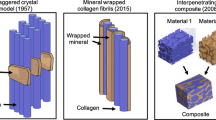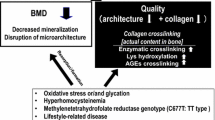Abstract
Bone collagen undergoes a series of enzymatic and nonenzymatic posttranslational modifications with maturation. The aim of this study was to analyze the collagenolytic efficiency of cathepsin K in relation to the extent of bone collagen age. Bone collagen posttranslational maturation was induced in vitro by preincubating bovine fetal cortical bone specimens at 37 °C for different times. The collagen enzymatic cross-links pyridinoline (PYD) and deoxypyridinoline (DPD), the advanced glycation end product pentosidine (PEN), and the native (α) and β-isomerized C-telopeptide (CTX) isomers were measured in each bone specimen. After extraction, bone collagen was incubated with human recombinant cathepsin K at different concentrations and its collagenolytic activity was measured by the release of hydroxyproline. To assess the affinity of cathepsin K for isomerized and nonisomerized CTX isomers, incubation with cathepsin K was also performed in the presence of various concentrations of a specific inhibitor. We showed that preincubation of bone collagen at 37 °C induces a marked increase in the bone concentration of PYD, DPD, and PEN and of CTX isomerization as reflected by the ratio of α-/βCTX. This increase was associated with a parallel increase in the efficiency of cathepsin K to solubilize bone collagen. When cathepsin K was incubated in the presence of an inhibitor, the β-isomerized form of collagen from 3-month- and 8-year-old bovine bone was more susceptible to degradation than the native α form. These results suggest that the collagenolytic activity of cathepsin K may be increased toward more matured bone collagen.





Similar content being viewed by others
References
Eyre DR, Oguchi H (1980) The hydroxypyridinium cross-links of skeletal collagens: their measurement, properties and a proposed pathway of formation. Biochem Biophys Res Commun 92:403–410
Eyre DR (1980) Collagen: molecular diversity in the body’s protein scaffold. Science 207:1315–1322
Robins SP, Bailey AJ (1972) Age-related changes in collagen: the identification of reducible lysine-carbohydrate condensation products. Biochem Biophys Res Commun 48:76–84
Sell DR, Monnier VM (1989) Structure elucidation of a senescence cross-link from human extracellular matrix. Implication of pentoses in the aging process. J Biol Chem 264:21597–21602
DeGroot J (2004) The AGE of the matrix: chemistry, consequence and cure. Curr Opin Pharmacol 4:301–305
Geiger T, Clarke S (1987) Deamidation, isomerization, and racemization at asparaginyl and aspartyl residues in peptides. Succinimide-linked reactions that contribute to protein degradation. J Biol Chem 262:785–794
Cloos PA, Fledelius C (2000) Collagen fragments in urine derived from bone resorption are highly racemized and isomerized: a biological clock of protein aging with clinical potential. Biochem J 345(Pt 3):473–480
Gineyts E, Cloos PA, Borel O, Grimaud L, Delmas PD, Garnero P (2000) Racemization and isomerization of type I collagen C-telopeptides in human bone and soft tissues: assessment of tissue turnover. Biochem J 345(Pt 3):481–485
Fledelius C, Johnsen AH, Cloos PA, Bonde M, Qvist P (1997) Characterization of urinary degradation products derived from type I collagen. Identification of a beta-isomerized Asp-Gly sequence within the C-terminal telopeptide (alpha1) region. J Biol Chem 272:9755–9763
Wang X, Shen X, Li X, Agrawal CM (2002) Age-related changes in the collagen network and toughness of bone. Bone 31:1–7
Nyman JS, Roy A, Tyler JH, Acuna RL, Gayle HJ, Wang X (2007) Age-related factors affecting the postyield energy dissipation of human cortical bone. J Orthop Res 25:646–655
Zioupos P, Currey JD (1998) Changes in the stiffness, strength, and toughness of human cortical bone with age. Bone 22:57–66
Knott L, Bailey AJ (1998) Collagen cross-links in mineralizing tissues: a review of their chemistry, function, and clinical relevance. Bone 22:181–187
Viguet-Carrin S, Follet H, Gineyts E, Roux JP, Munoz F, Chapurlat R, Delmas PD, Bouxsein ML (2010) Association between collagen cross-links and trabecular microarchitecture properties of human vertebral bone. Bone 46:342–347
Garnero P, Cloos P, Sornay-Rendu E, Qvist P, Delmas PD (2002) Type I collagen racemization and isomerization and the risk of fracture in postmenopausal women: the OFELY prospective study. J Bone Miner Res 17:826–833
Vashishth D, Gibson GJ, Khoury JI, Schaffler MB, Kimura J, Fyhrie DP (2001) Influence of nonenzymatic glycation on biomechanical properties of cortical bone. Bone 28:195–201
Viguet-Carrin S, Farlay D, Bala Y, Munoz F, Bouxsein ML, Delmas PD (2008) An in vitro model to test the contribution of advanced glycation end products to bone biomechanical properties. Bone 42:139–149
Valcourt U, Merle B, Gineyts E, Viguet-Carrin S, Delmas PD, Garnero P (2007) Non-enzymatic glycation of bone collagen modifies osteoclastic activity and differentiation. J Biol Chem 282:5691–5703
Garnero P, Borel O, Gineyts E, Duboeuf F, Solberg H, Bouxsein ML, Christiansen C, Delmas PD (2006) Extracellular post-translational modifications of collagen are major determinants of biomechanical properties of fetal bovine cortical bone. Bone 38:300–309
Henriksen K, Leeming DJ, Byrjalsen I, Nielsen RH, Sorensen MG, Dziegiel MH, Martin TJ, Christiansen C, Qvist P, Karsdal MA (2007) Osteoclasts prefer aged bone. Osteoporos Int 18:751–759
Gelb BD, Shi GP, Chapman HA, Desnick RJ (1996) Pycnodysostosis, a lysosomal disease caused by cathepsin K deficiency. Science 273:1236–1238
Garnero P, Borel O, Byrjalsen I, Ferreras M, Drake FH, McQueney MS, Foged NT, Delmas PD, Delaisse JM (1998) The collagenolytic activity of cathepsin K is unique among mammalian proteinases. J Biol Chem 273:32347–32352
Nishi Y, Atley L, Eyre DE, Edelson JG, Superti-Furga A, Yasuda T, Desnick RJ, Gelb BD (1999) Determination of bone markers in pycnodysostosis: effects of cathepsin K deficiency on bone matrix degradation. J Bone Miner Res 14:1902–1908
Delaisse JM, Andersen TL, Engsig MT, Henriksen K, Troen T, Blavier L (2003) Matrix metalloproteinases (MMP) and cathepsin K contribute differently to osteoclastic activities. Microsc Res Tech 61:504–513
Kafienah W, Bromme D, Buttle DJ, Croucher LJ, Hollander AP (1998) Human cathepsin K cleaves native type I and II collagens at the N-terminal end of the triple helix. Biochem J 331(Pt 3):727–732
Bossard MJ, Tomaszek TA, Thompson SK, Amegadzie BY, Hanning CR, Jones C, Kurdyla JT, McNulty DE, Drake FH, Gowen M, Levy MA (1996) Proteolytic activity of human osteoclast cathepsin K. Expression, purification, activation, and substrate identification. J Biol Chem 271:12517–12524
Bromme D, Okamoto K, Wang BB, Biroc S (1996) Human cathepsin O2, a matrix protein-degrading cysteine protease expressed in osteoclasts. Functional expression of human cathepsin O2 in Spodoptera frugiperda and characterization of the enzyme. J Biol Chem 271:2126–2132
Silver IA, Murrills RJ, Etherington DJ (1988) Microelectrode studies on the acid microenvironment beneath adherent macrophages and osteoclasts. Exp Cell Res 175:266–276
Li Z, Hou WS, Escalante-Torres CR, Gelb BD, Bromme D (2002) Collagenase activity of cathepsin K depends on complex formation with chondroitin sulfate. J Biol Chem 277:28669–28676
Li Z, Yasuda Y, Li W, Bogyo M, Katz N, Gordon RE, Fields GB, Bromme D (2004) Regulation of collagenase activities of human cathepsins by glycosaminoglycans. J Biol Chem 279:5470–5479
Viguet-Carrin S, Gineyts E, Bertholon C, Delmas PD (2009) Simple and sensitive method for quantification of fluorescent enzymatic mature and senescent cross-links of collagen in bone hydrolysate using single-column high performance liquid chromatography. J Chromatogr B Analyt Technol Biomed Life Sci 877:1–7
Cloos PA, Lyubimova N, Solberg H, Qvist P, Christiansen C, Byrjalsen I, Christgau S (2004) An immunoassay for measuring fragments of newly synthesized collagen type I produced during metastatic invasion of bone. Clin Lab 50:279–289
Bank RA, Krikken M, Beekman B, Stoop R, Maroudas A, Lafeber FP, te Koppele JM (1997) A simplified measurement of degraded collagen in tissues: application in healthy, fibrillated and osteoarthritic cartilage. Matrix Biol 16:233–243
Garnero P, Ferreras M, Karsdal MA, Nicamhlaoibh R, Risteli J, Borel O, Qvist P, Delmas PD, Foged NT, Delaisse JM (2003) The type I collagen fragments ICTP and CTX reveal distinct enzymatic pathways of bone collagen degradation. J Bone Miner Res 18:859–867
Bauer D, Garnero P, Harrson SL, Cauley J, Eastell R, Orwoll E (2010) Type I collagen isomerization (alpha/beta CTX ratio) and risk of clinical vertebral fracture in men: a prospective study. ASBMR 2010 Annual Meeting. J Bone Miner Res 25 (Suppl 1):S8
Li Z, Hou WS, Bromme D (2000) Collagenolytic activity of cathepsin K is specifically modulated by cartilage-resident chondroitin sulfates. Biochemistry 39:529–536
Saito M, Marumo K (2010) Collagen cross-links as a determinant of bone quality: a possible explanation for bone fragility in aging, osteoporosis, and diabetes mellitus. Osteoporos Int 21:195–214
Eyre DR, Paz MA, Gallop PM (1984) Cross-linking in collagen and elastin. Annu Rev Biochem 53:717–748
Bailey AJ, Paul RG, Knott L (1998) Mechanisms of maturation and ageing of collagen. Mech Ageing Dev 106:1–56
Atley LM, Mort JS, Lalumiere M, Eyre DR (2000) Proteolysis of human bone collagen by cathepsin K: characterization of the cleavage sites generating by cross-linked N-telopeptide neoepitope. Bone 26:241–247
Sassi ML, Eriksen H, Risteli L, Niemi S, Mansell J, Gowen M, Risteli J (2000) Immunochemical characterization of assay for carboxyterminal telopeptide of human type I collagen: loss of antigenicity by treatment with cathepsin K. Bone 26:367–373
Cao L, Goodin R, Wood D, Moscarello MA, Whitaker JN (1999) Rapid release and unusual stability of immunodominant peptide 45–89 from citrullinated myelin basic protein. Biochemistry 38:6157–6163
Pritzker LB, Joshi S, Gowan JJ, Harauz G, Moscarello MA (2000) Deimination of myelin basic protein. 1. Effect of deimination of arginyl residues of myelin basic protein on its structure and susceptibility to digestion by cathepsin D. Biochemistry 39:5374–5381
Eriksen EF (2010) Cellular mechanisms of bone remodeling. Rev Endocr Metab Disord 11:219–227
Garnero P, Fledelius C, Gineyts E, Serre CM, Vignot E, Delmas PD (1997) Decreased beta-isomerization of the C-terminal telopeptide of type I collagen alpha 1 chain in Paget’s disease of bone. J Bone Miner Res 12:1407–1415
Leeming DJ, Delling G, Koizumi M, Henriksen K, Karsdal MA, Li B, Qvist P, Tanko LB, Byrjalsen I (2006) Alpha CTX as a biomarker of skeletal invasion of breast cancer: immunolocalization and the load dependency of urinary excretion. Cancer Epidemiol Biomarkers Prev 15:1392–1395
Acknowledgements
We thank Dr. Jean Marie Délaissé for helpful discussion.
Author information
Authors and Affiliations
Corresponding author
Additional information
The authors have stated that they have no conflict of interest.
Rights and permissions
About this article
Cite this article
Borel, O., Gineyts, E., Bertholon, C. et al. Cathepsin K Preferentially Solubilizes Matured Bone Matrix. Calcif Tissue Int 91, 32–39 (2012). https://doi.org/10.1007/s00223-012-9604-7
Received:
Accepted:
Published:
Issue Date:
DOI: https://doi.org/10.1007/s00223-012-9604-7




